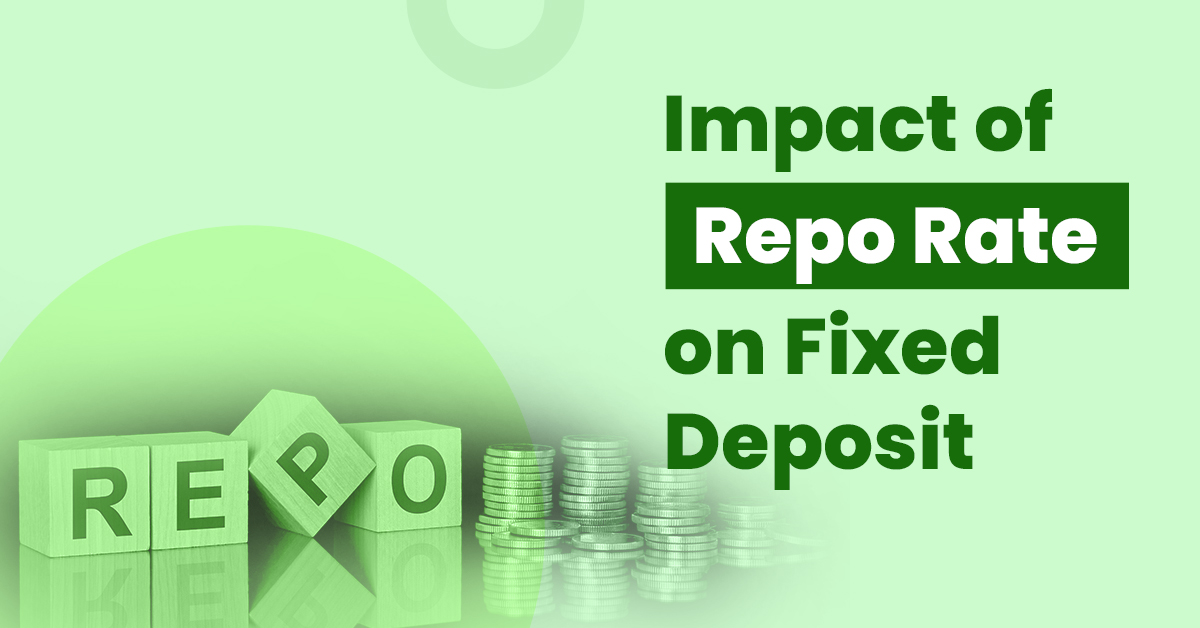How do changes in repo rate impact your FD interest rates?


Fixed deposits are one of the most popular investment options. They offer assured returns that are susceptible to very minimal market volatility. When you invest in an FD, you deposit a specific lump sum with a bank and earn a fixed rate of interest on it for the entire tenure of the deposit. This interest rate varies from bank to bank.
Before deep diving into the concept of repo rates, let’s understand how fixed deposits act as a source of funds for banks. Banks lend the funds held in FDs as loans. The difference between the interest paid on these deposits and interest earned by banks through loans extended is called Net Interest Income.
The risk pertaining to fixed deposits arises from the fact that the bank might face difficulty in honoring a large number of deposit withdrawals (if made at once) in one go. If the bank has given out too many loans and doesn’t have sufficient balance to pay the depositors, it will create panic in the market about the bank’s ability to meet withdrawal requests and credibility as a whole. A crisis of this nature might even lead to the bank’s collapse.
To avoid such a situation, banks maintain a certain degree of liquidity with themselves at all times. This liquidity changes daily due to the banks’ operations. RBI helps banks maintain this liquidity by lending them money at an interest rate known as the repo rate. This way, the repo rate directly impacts the banks’ cost of funds. This way, the repo rate directly impacts the banks’ cost of funds. Banks tend to alter the fixed deposit interest rates offered in order to factor in this.
Read on to learn more about the impact of repo rates on fixed deposit interest rates.
Also Read: Experience financial growth with unmatched Bajaj Finance FD Rates
What is Repo Rate?
The Repo rate refers to the rate at which RBI lends to banks. The term ‘repo’ stands for ‘Repurchase Option’ or ‘Repurchase Agreement’. By virtue of a repurchase agreement, banks sell their bonds or other securities to RBI in exchange for funds/loans. The underlying agreement causes banks to repurchase the securities at an amount equivalent to the initial loan amount and interest accrued on the same, after a pre-fixed period of time.
Banks borrow from RBI to meet their short-term liquidity requirements and/or to maintain their statutory ratios. RBI optimises the same as a tool to manage inflation. When the RBI predicts high inflation, it hikes the repo rate to disincentivise banks from borrowing from it. Banks then pass this on to the larger masses via the fixed deposit rate.
On account of rise on fixed deposit rates, it becomes more lucrative to save rather than hold/spend money. This causes the supply of money in the market to significantly reduce over time. When a lesser sum of money chases the same number of goods and services in the market (as production volumes are constant in the short run), prices come down. Inversely, when the RBI wants to infuse more money into the market to spur consumption and growth, it cuts the repo rate.
Impact of Repo Rate on FD Interest Rate
As discussed above, a hike in repo rates tightens the liquidity available to the banks. The cost of funds increases for the banks, and their profit margins reduce. Especially in scenarios where the demand for credit is high, and the RBI increases the repo rate, the banks face a high cost of funds, eroding their profit margins.
Banks try to solve this problem by acting on two fronts. They pass on some of this increase to their borrowers by increasing the lending rates. Loans become more expensive as a result.
Further, they try to reduce their borrowing from RBI by focusing more on the current account, savings account, and fixed deposits which are cheap sources of funds for banks. They incentivise customers to put more money in FDs by increasing FD interest rates. The surge in fixed deposit rates is reflective of this. This is a simple explanation of the repo rate impact on FD interest rates.
There are also cases where the repo rates increase, but the banks do not pass this increase to the customer. These instances occur when the demand for credit is so low that despite tightened liquidity, the bank doesn’t face a substantial decrease in liquidity.
The RBI encourages banks to pass on the changes in repo rates to customers via fixed deposit and savings account interest rates. It is prudent to note that, the reverse happens when the repo rate decreases. Loans become cheaper, and fixed deposit interest rates come down.
Repo rate changes are not proportionately passed on to customers. As banks take action depending on the liquidity and market demand.
The emergence of Repo-Linked Fixed Deposits
Banks have now started indulging in the practice of extending a repo-linked interest rate that enables an investor to benefit from favourable increments in Repo Rates. Ideally, an increase in Repo Rate would lead to a decline in Real Returns but through the instrumentality of a Repo-linked interest rate, the repo rate surge would be factored in, in a revised inflated interest rate.
Yes Bank has recently launched a floating rate FD linked to the repo rate. The duration of the same lies between 1-3 years and the minimum investment is Rs.10,000.
Final Thoughts
RBI uses the repo rate to manage inflation in the economy. Banks change FD interest rates based on the repo rate changes by the RBI. If the repo rate goes up then there are high chances of an increase in FD interest rates and vice versa. It will be beneficial for you to not lock in funds for very long tenure when RBI is aggressively increasing the repo rate.
Because with the repo rate increase, FD interest rates will rise. But you won’t be able to benefit from it as the interest rate on your FD will stay the same for the whole tenure. Now that you have understood the repo rate impacts on FD, it would hopefully aid your financial decision-making.
FAQs related to reverse repo rate
What is the reverse repo rate?
It is the rate at which the RBI borrows from banks. It is a liquidity management tool that the RBI uses to suck out excess cash from banks. Banks can park their surplus funds with the RBI for higher interest rates. This is a reverse repurchase agreement, where the RBI sells the securities to banks and promises to rebuy them later. The current reverse repo rate is 3.35%
What are SLR and CRR
The Statutory Liquidity Ratio (SLR) is the percentage of the deposits that banks must maintain in the form of liquid cash, gold or other securities. The current SLR rate is 18%.
Cash Reserve Ratio (CRR) is the minimum amount of cash as a percentage of their total deposits which banks must maintain as a reserve with the RBI. The current CRR requirement is 4.5%.
The purpose of the above two instruments is to manage banks’ liquidity.
What is MSF rate?
Marginal Standing Facility is a window banks can use to borrow funds from RBI instantly. It allows banks to meet their liquidity mismatches by borrowing up to 2% of their Net Demand and Time Liabilities (NTDL) from RBI at an interest rate above the repo rate. The current MSF rate is 6.15%
How does the bank rate differ from the repo rate?
A bank rate is a rate at which banks can borrow from RBI without any securities. On the other hand, banks can borrow from RBI using the repo rate by selling securities with the promise of repurchasing them later. Due to lower risk, the repo rate is always lower than the bank rate. The current repo rate is 5.9%, while the bank rate is 6.15%.
Does an increase in repo rates affect home loans?
Just as repo rate increase impacts FD interest rates, home loan rates also face the same impact. The way it works is simple. A repo rate hike means banks will pay more interest to borrow from the RBI. As a result, the banks will charge higher interest rates on home loans to balance their profitability.







